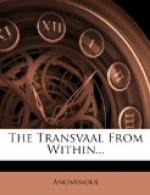The revenue of the company is now considerably over L3,000,000 per annum. The management claim that their expenses amount to but 40 per cent. of revenue, and this is regarded by them as a matter for general congratulation. The Uitlanders contend that the concern is grossly mismanaged, and that the low cost of working is a fiction. It only appears low by contrast with a revenue swollen by preposterously heavy rates and protected by a monopoly. The tariff could be reduced by one-half; that is to say, a remission of taxation to the tune of one and a half million annually could be effected without depriving the Company of a legitimate and indeed very handsome profit.
[Selati Railway.]
The Selati Railway Scheme! ’Conceived in iniquity, delivered in shame, died in disgrace!’ might be its history, but for the fact that it is not quite dead yet. But very nearly! The concession was obtained during the Session of 1890 by a member of the First Volksraad, Mr. Barend J. Vorster, jun., who himself took part in and guided the tone of the debate which decided the granting of the concession. The Raad resolved to endeavour to obtain the favourable opinions of their constituents, but before doing so the generous Mr. Vorster made what he was pleased to call ‘presents’ to the members—American spiders, Cape carts, gold watches, shares in the Company to be floated, and sums in cash—were the trifles by which Mr. Vorster won his way to favour. He placated the President by presenting to the Volksraad a portrait




